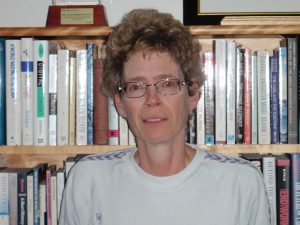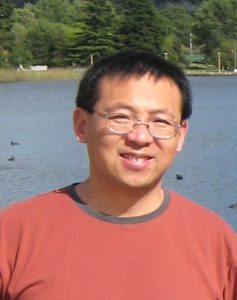BRANDON, Man. – Brandon University (BU) research projects in sub-atomic physics, vascular biology and fractional calculus have received significant federal funding through the Discovery Grant program.
The Natural Sciences and Engineering Research Council of Canada (NSERC) has awarded Discovery and Discovery Development Grants, totaling $360,000 of support, to three projects led by BU faculty members.

Dr. Margaret Carrington received a $200,000 Discovery Grant over five years to study new theoretical techniques that could allow scientists to better understand the interactions of sub-atomic particles. Dr. Mousumi Majumder received a $140,000 Discovery Grant over five years for research on the vascular system that could be used to develop more effective drugs. Dr. Chenkuan Li received a $20,000 Discovery Development Grant, as well as $10,000 from BU’s Office of the Vice President (Academic & Provost) to study an approach to integral equations that form the basis for physics and quantum field theory, among other applications.
“We are very happy to have NSERC funding for important research conducted at BU,” Carrington said. “NSERC support is vital for the continued success of the many productive research programs that are ongoing at Brandon University.”
In addition to funding important research, the grants will also help to create opportunities for students at BU.

“This NSERC Discovery Grant will allow two students who have been accepted to the Master of Science program at BU join my lab this fall,” Majumder said. “The experience that they gain working on this project will be invaluable in their studies and their future careers.”
Additionally, three BU students have received support for their research projects through the Canada Graduate Scholarships-Master’s (CGS-M) Awards:
- Alisha Poole, of BU’s Master of Science, Environmental and Life Sciences (MELS) program, received the Canadian Institutes of Health Research (CIHR) Frederick Banting and Charles Best Canada Graduate Scholarship for her project, Proteases Involved in Glioma Migration.
- Markus Sudermann, another MELS student, received the NSERC Alexander Graham Bell Canada Graduate Scholarship to fund his project, Palaeoecology of Ellesmere Island during the Eocene.
- Eva Goulet, of the Master of Rural Development program, was awarded the Social Sciences and Humanities Research Council (SSHRC) Joseph Armand Bombardier Canada Graduate Scholarship for her project, Family Violence in a First Nation Community of Manitoba.
The purpose of the CGS-M Awards is to develop research skills and assist the training of highly qualified personnel by supporting students who demonstrate a high standard of achievement in undergraduate and early graduate studies. They have a value of $17,500 over one year.
“The level of achievement demonstrated by our faculty and our students is remarkable,” said Dr. Austin Gulliver, Acting Dean of Science at BU.
“We are extremely proud to have these and many other world-class research projects being conducted right here at Brandon University.”
The announcement brings the total of BU faculty members leading active Discovery Grant or Discovery Development Grant research projects to 11.
“This marks of the continuation of a tremendous period of success for our researchers,” said Dr. Heather Duncan, BU’s Associate Vice-President of Research. “In 2016 our faculty members secured five new Discovery Grants, exceeding the total of the previous four years combined. This announcement by NSERC signifies another major accomplishment and is evidence that Brandon University research is increasingly being recognized nationally for its value and importance.”
Research Summaries
Dr. Mousumi Majumder
Molecular Determinants of Vertebrate Vasculature and Development ($130,000 for 5 years or $26,000/year)
From fish to human we are all vertebrates. In vertebrates vascular system is vital for blood circulation, gas and metabolite exchange, fluid balance and immune cell traffic. Formation of new vascular system in embryo is called vasculogenesis, and while this system gets mature is called angiogenesis. The latter participates in inflammation, wound repair and also tumor growth. The process of vasculogenesis is very complex and the role of many molecules involved in this process are not yet known. I want to investigate the roles of micro RNA (miRNA) in vasculogenesis. MiRNAs are short noncoding RNAs, produced within our body and plays major role in embryonic development and also in disease pathogenesis.
With the support of NSERC discovery grant this research program aims to identify novel molecular determinants responsible for embryonic growth and vasculogenesis in the vertebrate system. We shall use human cell lines and Zebra fish models to investigate the above notion. Why this research is important? There are several painkillers we use in everyday, like Aspirin for headache or Celecoxib for arthritis. These drugs inhibit production of Prostaglandin E2 (PGE2), which is known for inflammation and pain generation. By blocking PGE2 are we affecting other cellular functions? We do not know yet. Once we know the biology and functions of PGE2 and PGE2-induced miRNAs in vascular development and in embryonic growth, this program will modify the course of currently used drugs.
Dr. Margaret Carrington
Non-Perturbative and Out-of-Equilibrium Field Theories ($200,000 for five years or $40,000/year)
Physicists are very interested in physical systems that are strongly interacting. The main reason is that quantum chromodynamics (QCD), the theory that governs the interactions of subatomic particles on a nuclear level, is strongly interacting. It has been known for years that this property of QCD is responsible for many of the unusual and interesting properties of nuclear matter. However, the standard calculational techniques that have been developed by generations of physicists, largely in the context of quantum electro-dynamics (QED), are not applicable to strongly coupled systems. For this reason, the behavior of these systems is less understood.
It is important for the progress of science that theorists keep pace with experimental programs. Accordingly, there has been much recent work on the development of theoretical techniques to calculate observables in strongly coupled and non-equilibrated systems. This work is both difficult and exciting. It involves the invention of completely different mathematical methods to describe physical situations that were previously considered beyond our ability to describe mathematically. One goal of my research program is the development of a particular non-perturbative formalism (which is called the nparticle irreducible action), and its application to strongly coupled quantum field theories. Another major goal is the development of techniques to understand the dynamical role of plasma instabilities.
Dr. Chenkuan Li
Fractional Calculus of Distributions and Integral Equations ($20,000 for two years or $10,000/year plus $10,000 from BU Office of the VP (Academic & Provost))

Studying Abel’s integral equations (the first and second kind), as well as their variants in the generalized sense, has been a serious challenge. The long term goal of my research proposal is to define fractional calculus of distributions (or generalized functions) in general by convolutions and approximations, which is novel in distribution theory. This will require the development of new methods of computing integrals of generalized functions over the Schwartz space or a subspace.
Subsequently, I plan to investigate integral equations, particularly Abel’s integral equations, in the distributional sense by inverse operators in terms of convolution, and study approximate solutions, their convergence and order of approximation in Big-O notation under topological structures. Additionally, I intend to give meaning to singular distributions encountered, while solving integral equations, by delta sequence and complex analysis approaches, as they are also widely needed in physics, quantum field theory and differential equations involving distributions.
The significance of the work is the following: Many applied problems from physical, engineering and chemical processes lead to integral equations, which at first glance have nothing in common with Abel’s integral equations, and due to this perception, additional efforts are undertaken for the development of analytical or numerical procedures for solving these equations. However, through the application of my convolution approach, their transformations to the form of Abel’s integral equations will speed up the solution process, or, more significantly, lead to distributional solutions in cases where classical ones do not exist.
Contact
- Brandon University
- communications@brandonu.ca
To receive any BU publication in an alternate format please contact Communications@BrandonU.ca
About BU
Success is built at Brandon University. Our growing, progressive campus welcomes a diverse and inclusive community that combines proud tradition with shared ambition. Through our excellence in teaching, research, and scholarship, we educate students to make a meaningful difference as engaged citizens and leaders. Join us at BrandonU.ca.